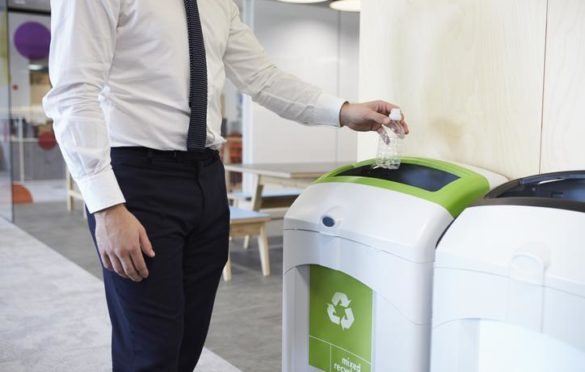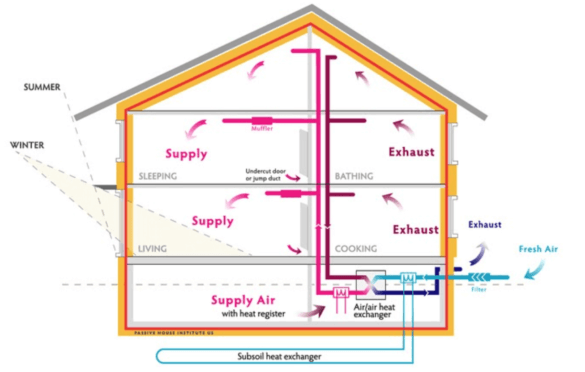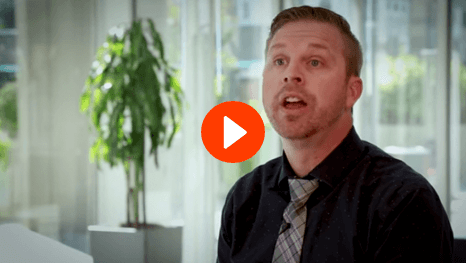Eco-friendliness and going green is about more than just recycling your empty soda cans. It encompasses all the things you can do as a human on this planet to minimize your impact on it as much as possible. Here, we’ll talk about some of the simplest ways that you, as a property manager, a landlord, or a homeowner, can reduce the burden you put on Mother Earth, save energy at home, and achieve environmentally friendly real estate. You can also head back to our
Learning Center for more tips on related subjects.
Reduce, reuse, and recycle (properly!)
Did you know that recycling one plastic bottle can save enough energy to power a light bulb for up to four hours? What’s more, recycling water bottles saves 50% of the water pollution and 20% of the air pollution used to create new bottles. That’s why recycling, or reusing/reducing consumption of plastics and recycling them properly when the time comes, should be one of our top priorities as inhabitants of this planet. This is just a small part of going green.
SHOCKING FACTS ABOUT RECYCLING
You probably know already that it’s good to recycle, but do you know just how influential it can be to recycle even if only on occasion? Here are some eye-opening facts that will motivate you to recycle your plastic, aluminum, cloth, and paper goods more frequently.
- The Coke can you throw away today will still be rolling around the landfill 500 years from now. When it is recycled, that aluminum can will be back on supermarket shelves in as few as six weeks, ready for another use.
- When you recycle one can, you save enough energy to power a TV in three different households.
- The average home disposes of 13,000 sheets of paper per year that could be recycled. You use approximately seven trees each year in your use of paper goods.
- Approximately 25,000,000 bottles are thrown away each hour in the United States, which takes double the energy to burn than to recycle.
- A glass bottle takes 4,000+ years to break down, when it could be recycled instead.
- Americans dispose of nearly ten times the amount of waste compared to people in Central America or Africa.
- For every one mile of the highway, there are about 1,500 items of garbage on the ground.
- Clothing comprises 5% of the landfills because people don’t think to donate it instead of throwing it away.
TECHNIQUES FOR PROPER RESIDENTIAL AND COMMERCIAL RECYCLING
These disturbing facts are enough to spur anyone into action. But before jumping headfirst into recycling for the first time, review these recycling basics so that your efforts actually have a positive impact; some people, even with the best of intentions, try to recycle items that are non-recyclable and end up doing more harm than good to the environment. The general guidelines below will help you to recycle properly and help you take the next steps to going green.
RECYCLABLES VS NON-RECYCLABLES
First things first, let’s review what is and isn’t accepted in your recycling bin, according to
Waste Management:
YES
- Paper
- Collapsed boxes and cardboard
- Clean, dry cans
- Clean, dry bottles and plastic containers
- Clean, dry glass bottles and other glass containers
NO
- Plastic bags
- Compostable plastics
- Batteries or electronics
- Greasy pizza boxes (or other dirty food packaging)
- Wax- or plastic-coated cups
- Polystyrene foam or plastic
- Flexible packaging
- Plastic wrap
- Recyclables in a bag
- Dirty diapers
- Prescription drug bottles
- Medical waste
- Garage waste
- Household items (donate shoes and clothes or throw away)
- Food or liquid
- Plastic dishware
RECYCLING BEST PRACTICES
Now that you know what can and cannot typically be recycled (check with your local recycling facility as well to confirm that these lists align with your city’s recycling practices and regulations), here are some
general guidelines provided by Recycle Across America, for proper recycling.
- Follow recycling instructions. If the packaging of your recyclable or the recycling bin itself has instructions on it, try to follow them as closely as possible. Some recycling bins are specifically for cans while others may be designated for cardboard and paper.
- Check for the number on plastic containers. You can always recycle plastic jugs and bottles that have a #1 or #2 on the bottom, but put the cap back on the empty container before recycling. Plastics #3 through #7 aren’t always accepted, so do a quick check beforehand and if you aren’t sure, throw them away to avoid potential recycling contamination.
- Empty glass jars and remove the metal lids. If you recycle glass bottles, jars, or containers, remember to remove the metal lids and to empty the food from the vessel before recycling. You don’t necessarily need to wash them out, but do make sure they’re empty. (Certain communities have stopped recycling glass, so check with your city before attempting to recycle this material.)
- Remove the tape from your boxes when possible. When you have time, remove any tape from your cardboard boxes before recycling them to make the process easier for recycling plants. It’s not a requirement, but the employees appreciate you completing this step for them.
- Do not bag recyclables. When the time comes to empty your home or office recycling bin, do not bag the items you intend to throw away. The bag can get stuck in recycling processing equipment and cause major delays. Instead, dump out the loose items into your recycling bin.
HOW THE RECYCLING PROCESS WORKS
Recycling is a repetitive three-step process that involves the continuous collection and processing, manufacturing, and selling of recycled goods.
In the collection and processing phase, recyclable materials are taken to a facility in which they are sorted, cleaned, and turned into new materials (AKA the manufacturing process). Common products that are manufactured using recycled materials include paper towels, cereal boxes, egg cartons, trash bags, drink containers, detergent bottles, and newspapers. You close the recycling loop by purchasing them — but see to it that when you’re shopping for these items, they are labeled as recyclable and made of recycled materials.
THE BENEFITS OF RESIDENTIAL AND COMMERCIAL RECYCLING
When most people think of going greena and recycling, the first benefit that comes to mind is usually keeping non-degradable wastes out of landfills — but there’s so much more to going green!
Recycling helps us conserve and make the most use of Earth’s precious natural resources, such as water and trees. It reduces the pollution created and the energy consumed when collecting these materials and producing the goods we use every day. Recycling even helps the American economy by supporting domestic manufacturing and creating jobs here at home, which account for tens of billions of dollars in
annual U.S. wages, according to an EPA report.
Additionally, businesses who make efforts to go green are looked upon more favorably by the public, as consumers today prefer to give their business to those who are showing their concern for the environment. So, if you’re looking for ways to bolster your company’s reputation, you may find that this is your opportunity. Don’t be surprised if you even drum up new business as a result of your efforts!
EASY WAYS TO REDUCE YOUR WASTE OUTPUT
Recycling is just one of the many small lifestyle changes you can make to reduce the amount of waste you contribute to landfills each day. Here are some quick and affordable ways to reduce your carbon footprint (these tips may even help you reduce your household clutter and save some money!).
- Opt for reusable shopping bags or recyclable paper ones over plastic bags
- Buy a reusable coffee or soda cup for your trips to gas stations and cafes
- Steer clear of single-use silverware, straws, and cups
- Get the digital format of your paper magazine or newspaper subscriptions
- Invest in a reusable water bottle
- Compost your food scraps or give them to someone who likes gardening
- Bring reusable dishes to work
- Buy second hand goods and clothing
- Buy in bulk to minimize packaging waste
- Request email receipts in place of paper ones
- Opt out of junk mail

Participate in "going green" projects around your neighborhood
Your efforts to live green can extend beyond your workplace and your home. Below are some of the ways you can work toward a greener neighborhood and community.
TALK TO YOUR NEIGHBORS
If you have good relationships with your residential and/or commercial neighbors and feel that the community as a whole could up its recycling game, an easy way to get them on the recycling bandwagon is to talk to them about what you’re doing and offer your help wherever you can, whether it’s as simple as being a resource to answer questions people have about going green or as involved as teaching people how to compost. You never know who may be inspired to follow in your footsteps!
TAKE TURNS WITH THE RESPONSIBILITY
Since electronics, certain glass products, clothing items, and more can’t be recycled in a blue bin, you and your neighbors might take turns running these things to donation stores, holding garage sales, or taking them to their proper recycling facilities. Perhaps you could even host a neighborhood garage sale for your unwanted clothes, dishware, or electronics.
If this doesn’t garner interest, you’d be hard-pressed to find a person who doesn’t enjoy fresh, local produce. Bring up the idea of a community garden in which everyone puts in equal work and takes a portion of the harvest. Divide up the duties so that there’s a rotation for the weeding, pruning, watering, and fertilizing. This is an excellent way to obtain food with a minimal carbon footprint.
Another way to promote eco-friendly habits in your community is to offer a ridesharing schedule when you know that your neighbors frequent many of the same places as you do, such as the local schools, the gym, or the grocery store. Not only does this carpool arrangement benefit the environment, but you could also end up making some great friends and having fun along the way!
Finally, if litter is a big problem around the areas in which you live and work, be the change you want to see by setting up a community cleanup. Team up with local residents to pick up trash in the streets in an effort to make your city a cleaner, nicer place to live. Businesses can also garner some great PR by organizing and carrying out community cleanup as a company.

Set a green-friendly example in your office
Many employers are so busy running their office each day that they don’t even have time to think about going green. Even if you don’t have much bandwidth to invest in sustainable office solutions, there are quick and easy measures you can take to turn things around. Whether you try these all at once or make a goal to incorporate one idea each month, every person who participates or is affected will become more aware of their habits and more likely to go green in other aspects of their lives as well!
- Conduct an energy audit: Dedicate time to walking around your office before work or during lunch to identify places where your building is wasting power for a lower energy bill. A walkabout may help you discover new ways to practice energy conservation. Perhaps you could switch your lighting to high-efficiency LED bulbs that last longer and use less energy than conventional bulbs.If you’re not sure what to look for during an energy audit, you can sign up to have someone conduct one for you. Most states provide no-cost energy audits to businesses in order to help more workplaces go green.
- Minimize paper consumption: With everything going digital, there’s little need for paper anymore. Make sure your company memos, contracts, reports, and other documents are digitized and sent via email instead of paper copies whenever possible.
- Make recycling bins available: Most people want to recycle — and they will, given enough receptacles. Be sure to provide sufficient recycling bins around the office for paper, cans, plastic, aluminum, and glass, and be familiar with recycling drop-off sites if you are responsible for emptying the bins yourself. You can dispose of toner cartridges at places like Walmart, Staples, Office Depot, and BestBuy.
- Upgrade to solar energy and efficient appliances: Solar is an investment that may be pricey upfront, but these upgrades can yield amazing energy savings and tax credits. If your work environment expends a lot of energy on refrigerators, coffeemakers, and/or dishwashers, look into more energy-efficient appliances as well.
- Choose green suppliers: What items around your office could you buy recycled rather than new? Today, you might be surprised to find how many different office supplies are made from 100% recycled content, including whiteboard markers, tape, sticky notes, pens and pencils, paperclips, and more. If you go through a lot of ink, buy it through a company like Xerox, which allows its customers to send back empty cartridges for recycling. Take things a step further by choosing green suppliers who are local to your area to reduce shipping emissions.
- Celebrate Earth awareness days: Make your employees and clients more aware of the earth and what they can do to take care of it by observing and marketing Earth-centered holidays. Some of the most prominent ones are Clean Energy Month in March, Earth Day and Arbor Day in April, National Bike to Work Day in May, and Energy Action Month in October.
- Clean with environmentally friendly chemicals: Building managers can do their part for the earth by eliminating harsh, toxic chemicals from their cleaning arsenal. When these kinds of dangerous chemicals go down the drains, they can have a negative impact on the local water supply. If possible, make the switch to chemicals formulated with biodegradable, natural ingredients for the health of your workspace and the environment as a whole.

Employ passive house design methods for energy conservation
Passive houses are ones that have been designed to self-regulate with little need for heating or cooling. If reducing your ecological footprint is important to you, environmentally friendly real estate can help you accomplish this goal and maximize energy conservation without reducing your quality of life. Some of the green housing elements you could incorporate into a new build (and potentially an existing structure) include:
- High-performance windows for optimal insulation
- Moisture-reducing ventilation systems for excess humidity
- Solar energy for heating
- Connected insulation for heat retention
- Smart irrigation systems for water conservation
THE ADVANTAGES OF GREEN RETROFITTING AT HOME
Generally, passive houses are built from scratch, but not everyone wants to fork out the money for a new construction in order to save energy at home. Fortunately, it’s possible to retrofit your property to make it more environmentally friendly. You’ll need some serious capital upfront to perform the upgrades, but the United States Department of Housing and Urban Development may offer you a Green Retrofit Grant or Green Retrofit Loan to help (more on those
here). If you don’t meet their eligibility requirements, rest assured that green housing will quickly pay itself off. Here’s how:
- Environmentally friendly real estate is desirable. Years ago, the ecologically sustainable design was considered a luxury, but those days are long gone. Now, buyers and renters expect their properties to come with green features knowing it’s not only better for the environment but produce a lower energy bill in the long run. If going green long-term is important to them, it needs to be important to you! It’s difficult to predict the future of real estate, but environmental sustainability will likely continue to be a hallmark of good property ownership and management.
- It can benefit your properties. Renters aren’t the only ones demanding green initiatives; property owners and managers can see, on a daily basis, how environmentally friendly real estate saves energy at home, reduces their overall operating costs, and increases their bottom line.
- It can help you sleep at night. If you’re worried about the impact your properties are having on the environment, fear no more. Green initiatives ensure you’re doing everything in your power to minimize your carbon footprint. Now THAT makes for sound sleep — tonight and every night!
- It could make a home easier and more valuable to sell in the future. If you don’t plan to sell for a while, green upgrades can still save you money while you wait by helping you lower your energy bill (a Smart Rain system, a solar panel, etc. are also very attractive features to real estate investors!).
- It benefits your health. There are the undeniable health benefits of living in a greener environment, which can be a great relief to your tenants (or yourself) should your properties house asthma and/or allergy sufferers.
Consume environmentally-friendly foods
Here’s an eye-opening fact: around two-thirds of the water you use in your life is used to make the food you eat. You can significantly reduce the amount of water you use, however, by becoming aware of which foods are better for the environment.
As a general rule of thumb, the less processed the food, the better it is for the environment. So, try to opt for more fresh produce and items that can go from vine to table. You can find these at farmer’s markets. If you have to buy processed foods, do so at local stores when possible to reduce the energy spent on transport.

Invest in water conservation
Effective property management requires a lot of water to keep commercial properties looking their best. But in conditions of drought, property managers need to learn how to use just enough water for their lawns without being wasteful. The
EPA reports that up to 50% of the 9 billion gallons of outdoor water used each day is wasted due to irrigation inefficiencies and overwatering.
Instead of doing away with grass in favor of low-maintenance landscaping materials like stone, look into smart sprinkler systems from Smart Rain to conserve water.
Learn why Smart Rain technology is a great choice:

These systems take all the guesswork out of watering the lawn by sensing when a specific zone has gotten enough water for its needs and shutting off automatically. They also alert you to any leaks in the line that are causing water waste. Users of smart irrigation systems find that they use up to 20% less water than they would with traditional systems.
See how it works:

Water conservation on a commercial property could also mean investing in water-saving sinks and toilets. Based on
figures from the EPA, replacing an inefficient flushometer-valve toilet with a more eco-friendly model, for example, could save 1.2 million gallons of water annually, translating to $10,000 in savings per year!
To learn more about water conservation and effective property management, follow the links below.
Conserve Water More EffectivelyBecome a Better Property ManagerPlant trees within your community
Trees are critical to our delicate ecosystem. They offer oxygen, food, shade, timber, and much more. Unfortunately, rampant wildfires and rapid deforestation are threatening to exhaust this vital natural resource — but you can help. Whether by yourself or in a group, find places to plant trees. You can plant them in your own backyard or find city service projects to participate in that involve the planting of trees in local parks, recreation centers, senior facilities, and more.
Do your part to combat pollution
Utah is known for having some of the worst air in the nation, especially during the winter when pollution gets trapped in the valley and creates a hazy inversion. So rather than driving your own car everywhere you go, stretch your legs and walk more whenever possible. Carpool to work with coworkers who live around you or use public transportation like the bus or the UTA TRAX light rail system.
As an employer, you could even subsidize a UTA pass to encourage employees to take public transit to work each day. If you already provide transportation for employees, make sure you do it with high-efficiency vehicles if you aren’t already. Not only does this help the environment, but it also promotes public health, saves on gas money, and reduces miles and wear on your car.
Find more ways to help the environment with Smart Rain
An eco-friendly life is a happy life, and the tips we’ve discussed above are just the beginning of the many ways you can get there. If you’d like additional information or want to team up with Smart Rain to achieve greener real estate,
get in touch with us today. We can’t wait to work with you toward our shared goal of environmental friendliness.








